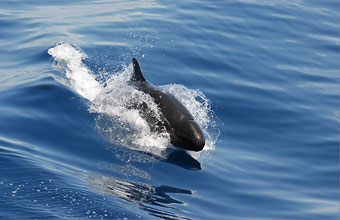

 | |||||||
|
|
Journals 2007/2008Heather Judkins
November 19, 2007 The past couple of days have been very busy for the marine mammal observers. The section of transect that we finished yesterday had many more sightings than I have seen yet this leg! We went through the passing and closing days with about 20 sightings each day! There was also more diversity in animals sighted than in the past two weeks. I saw Risso's dolphins, rough toothed dolphins, many spinner and spotted dolphins and my second Blue Whale! It was literally right next to the ship on the port side. Extremely cool! I will have to say though that the highlight came for me yesterday as we were in closing mode. The observers spotted a scattered but large group of Pseudorcas. The common name for this group of animals is the false killer whales. They were ahead of us about 4 miles out when they were first seen. The group didn't seem to "run" as other groups have and the decision was made to launch the small work boat to attempt biopsy samples from the animals.  What did that mean for me? I got to go! The team for the biopsies is Juan Carlos and Ernesto for biopsies, Adam for photography identification, and the teacher-at-sea! My role was to stay the heck out of the way :) After the decision was made to go; we were assembled on the deck for boat entry. Kevin was the captain and we were granted permission to board, the boat crew lowered us down to the water, Juan Carlos released this large hook that was keeping us attached to the ship and away we went! The whales during this time had gotten close enough to attempt sampling from the ship so our first job was to retrieve the darts that were shot from the ship in the water. They had fired three darts and one was successful! We then started out for the group of false killer whales. They were ahead of the ship still, about 2-3 miles out. We scanned the area and headed toward a small group for samples. The false killer whales tend to spread out in their quest for food and that is what it looked like they were doing to me. We steadied up next to one, waiting for it to come out of the water and Juan Carlos and Ernesto fired the darts. We collected the darts from the water and discovered we didn't get a sample. We attempted this process a few more times with different whales before returning to ship. All in all, we only collected one biopsy sample but it was well worth it for me to have the opportunity to get so close to them in their natural environment! One of the things I found interesting was that as we were tracking the whales, they leave what the scientists call a "footprint" or "flukeprint" behind. It is a small circular patch of water from their flukes as they are swimming near the surface. I couldn't see that from the ship as we have been watching the animals from a distance. Marine Science Questions: 1. Describe the biology of the False Killer Whale. Include size, life span, diet, and weight. 2. Are there any False Killer Whales in the Gulf of Mexico? If so, where? |
||||||